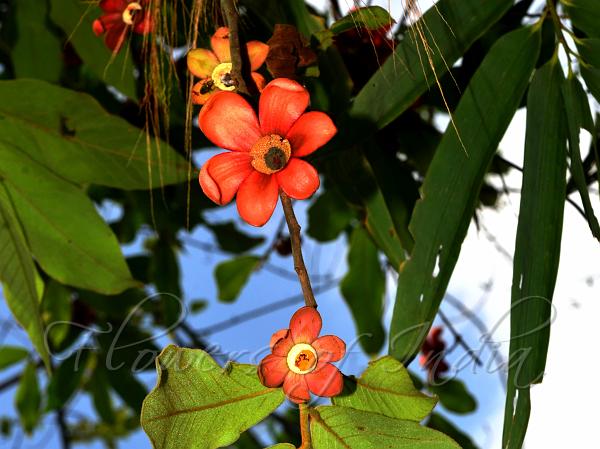|
| Eastern Uvaria |
|

|

| File size | 672943 |
| Original date | 5/19/18 7:43 AM |
| Resolution | 2048 x 1536 |
| Flash | Flash fired, return detected |
| Focal length | 60.0mm |
| Exposure time | 1/250s |
| Aperture | 14.0 |
| Focus Distance | |
| Metering Mode | Spot |
| Camera make | NIKON CORPORATION |
| Camera model | NIKON D7000 |
| Sensor type | OneChipColorArea |
|
|
|
|
Photo: |
Botanical name: Uvaria hamiltonii Family: Annonaceae (Sugar-apple family)
Eastern Uvaria is a large woody climbing shrub, with
brilliant red flowers. Flowers are bisexual or unisexual, usually
solitary or 2-3 fascicled, extra-in leaf-axils or in leaf-axils, brick
red, about 5-6 cm in diameter, flower-stalks woolly, about 2.5-4 cm
long, buds top-shaped, bract, basal, nearly round, leaf-like, about
0.5-1 cm long. Sepals are 3, broadly ovate or triangular, base fused,
tip blunt, reflexd, fulvous brown woolly outside, velvet-hairy inside.
Petals are 6, in 2 series, nearly equal, obovate, tip curved inwards,
blunt, leathery, brick red, brown woolly on both sides of the curved
tip, about 2.3-3 x 1.2-1.5 cm across, inner petals almost similar as
outer petals. Stamens are many, about 3-4 mm long, anthers linear,
nearly stalkless. Branchlets are softly rusty woolly, when young,
becoming hairless when mature, often circinate. Leaves are simple,
alternate, obovate-oblong or elliptic-oblong, 15-24 x 6-11 cm across,
base slightly heart-shaped or rounded, margin entire, tip deeply
pointed, shallow tapering, papery, membranous, dark green, nearly
hairless paler densely rufous star-shaped velvet-hairy beneath, lateral
veins 18-25 on either side of the midrib. Leaf-stalk is softly woolly,
about 0.3-0.5 cm long. Eastern Uvaria is found in Eastern Himalayas,
from Nepal to NE India, Burma, and Thailand, at altitudes of 300-600 m.
It is also found in Andaman and Odissa.
| Identification credit: M. Sawmliana | Photographed in Mizoram. |
• Is this flower misidentified? If yes,